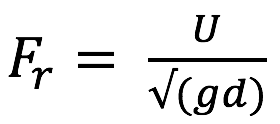6th March: a “Hydraulic Lepe”!
In a previous post I suggested that the reason that the position of Lepe Spit shows up in the lefthand photo (taken in June 2019) was because, with a southwest wind blowing against the tide, the wind generated waves can’t progress against the enhanced current over the spit resulting in an area of calm water to the east of the spit. However that explanation does not hold for the righthand photo taken on 6th March 2022. On that occasion the wind was ENE force 4 to 5 and, at 30 minutes after high tide Portsmouth, both wind and current were going westwards. It therefore seems surprising that the water upwind of the spit is smoother that the water downwind and down current. Indeed there appeared to be waves approaching the spit from the west, apparently travelling upwind. This was so noticable that a member of the public asked me what was causing the observed waves? The only answer that I could think of was that the spit was causing a hydraulic jump, was I correct?
 So could Lepe Spit create a hydraulic jump as the tidal currents flow over it? A hydraulic jump occurs when fast flowing water enters a region of slower flow. The type of hydraulic jump which might occur can be determined using the Froude number Fr which depends upon the current speed U, the water depth d, and gravitational acceleration g. The jump occurs where supercritical flow (Fr>1) changes to subcritical flow (Fr<1). A classic example of a hydraulic jump is the wave at the bottom of a weir or dam spillway which kayakers call a “stopper”. For that case the rapid water flow upstream of the jump has a Froude number greater than 9, often significantly greater.
So could Lepe Spit create a hydraulic jump as the tidal currents flow over it? A hydraulic jump occurs when fast flowing water enters a region of slower flow. The type of hydraulic jump which might occur can be determined using the Froude number Fr which depends upon the current speed U, the water depth d, and gravitational acceleration g. The jump occurs where supercritical flow (Fr>1) changes to subcritical flow (Fr<1). A classic example of a hydraulic jump is the wave at the bottom of a weir or dam spillway which kayakers call a “stopper”. For that case the rapid water flow upstream of the jump has a Froude number greater than 9, often significantly greater.
On the 6th March the tidal range was 3.7m and the flow over Lepe Spit was probably about 3 knots. Where the spit reduced the water depth to 20cm the Froude number would be just supercritical at 1.1 whereas downstream of the spit at 0.5m the flow would have been subcritical with a Froude number of 0.7 or less (given the slower water flow). Upstream Froude numbers between 1 to 3 result in a weak or “undulating” hydraulic jump. This fits with what was observed on the 6th March as shown in the following video.



